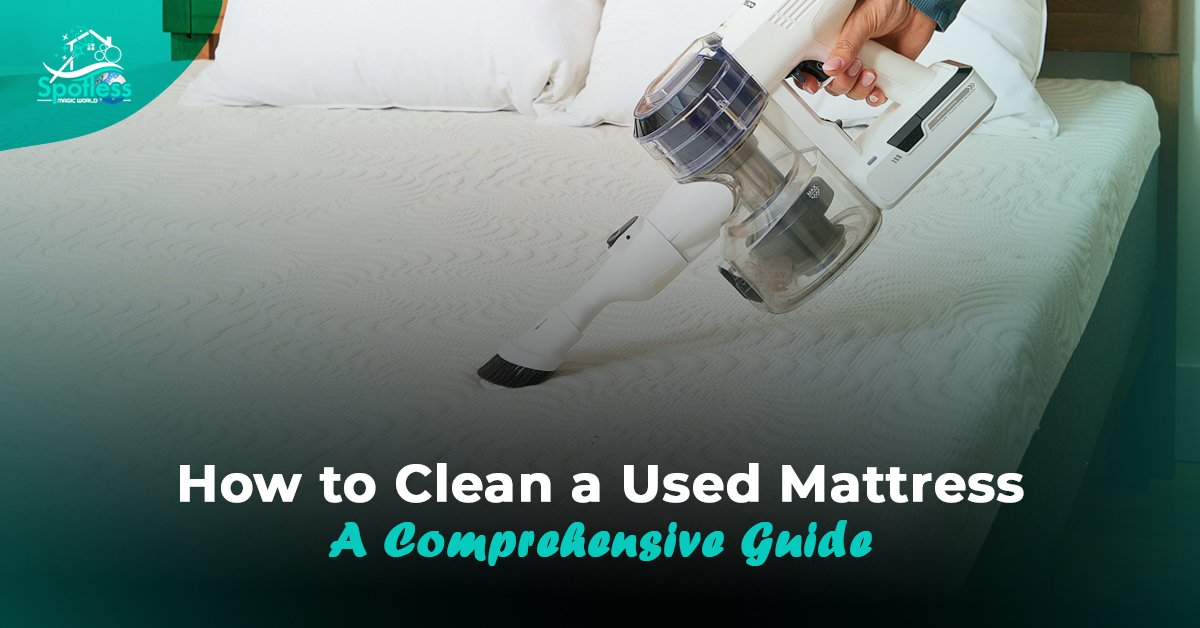Licensed And Insured

How to Clean a Used Mattress: A Comprehensive Guide
Buying a used mattress can be a smart choice for budget-conscious shoppers, but it’s essential to ensure that it’s clean and safe before you sleep on it. Many people overlook the importance of proper mattress hygiene, which can lead to discomfort and health issues.
This comprehensive guide will show you how to clean a used mattress, covering everything from basic cleaning techniques to deeper sanitization methods. Whether you’re dealing with stubborn stains or simply want to refresh an older mattress, this guide will help you achieve a clean and inviting sleep surface.
How to Clean a Used Mattress
Gather Your Supplies
Before diving into the cleaning process, it’s important to gather all the necessary supplies to ensure an effective cleaning session.
Here’s what you’ll need:
- Vacuum Cleaner with Upholstery Attachment: This is crucial for removing dust, dirt, and allergens from the mattress surface. The upholstery attachment helps reach into seams and crevices where particles often hide.
- Mild Detergent: A gentle detergent is essential for spot cleaning stains without damaging the fabric of the mattress.
- Spray Bottle: Use this to mix and apply cleaning solutions efficiently. A spray bottle allows for even distribution of liquids.
- Baking Soda: This versatile product not only deodorizes but also helps absorb moisture, making it ideal for freshening up the mattress.
- White Vinegar: Known for its disinfectant properties, white vinegar can effectively sanitize the mattress and neutralize odors.
- Clean Cloths: Soft, absorbent cloths are needed for blotting stains and wiping down surfaces. Microfiber cloths work well for this purpose.
Vacuum the Mattress
Start the cleaning process by thoroughly vacuuming the entire surface of the mattress. This step is essential for removing dust, dirt, and allergens that may have accumulated over time. Use the upholstery attachment to reach all areas, including seams, corners, and edges, where dust tends to gather. Be thorough—this initial step lays the groundwork for effective cleaning and will significantly improve the overall hygiene of your mattress.
Spot Clean Stains
Next, inspect the mattress for any visible stains. To tackle these, prepare a cleaning solution by mixing a few drops of mild detergent with warm water in a bowl or spray bottle. Dampen a clean cloth with the solution—be sure not to soak it, as excess moisture can lead to mold growth.
Gently blot the stained area, starting from the outside and working your way inward to avoid spreading the stain. After you’ve treated the stain, use another clean, damp cloth to wipe away any soap residue, ensuring that the mattress is left clean and free from detergent.
Deodorize with Baking Soda
After vacuuming and spot cleaning, it’s time to deodorize the mattress. Sprinkle a generous amount of baking soda evenly over the entire surface. Baking soda is a natural deodorizer that absorbs odors and moisture, making it an excellent choice for freshening up your mattress. For optimal results, let the baking soda sit for several hours or, ideally, overnight.
This allows it to penetrate deeply and neutralize any lingering smells. Once the time is up, vacuum the baking soda thoroughly, ensuring that no residue remains. Your mattress will not only look clean but will also smell fresh and inviting.
How to Deep Clean a Used Mattress
Deep cleaning a used mattress is crucial for removing allergens, bacteria, and odors, ensuring a safe and healthy sleep environment.
Here are the steps to effectively deep clean your mattress:
Use Vinegar for Disinfection
One of the most effective natural disinfectants is white vinegar. To prepare your cleaning solution, mix equal parts of white vinegar and water in a spray bottle. Vinegar not only disinfects but also neutralizes odors, making it ideal for refreshing your mattress.
Begin by lightly misting the mattress with this solution, taking care not to saturate it. Focus on areas that may harbor bacteria or odors, such as seams and corners. Once sprayed, let the solution sit for at least 15 minutes. This waiting period allows the vinegar to penetrate the fabric and disinfect effectively. Afterward, take a clean cloth and blot the mattress to absorb any excess moisture. This step not only helps sanitize the mattress but also keeps it fresh and inviting.
Steam Clean (If Possible)
If you have access to a steam cleaner, this tool can significantly enhance your deep cleaning efforts. Steam cleaning uses high temperatures to eliminate dust mites, bed bugs, and other allergens that can lurk within the mattress fibers.
Begin by vacuuming the mattress to remove surface dirt and debris. Then, follow the manufacturer’s instructions for your steam cleaner. Move the steam cleaner slowly across the mattress surface, allowing the heat to penetrate deeply into the fabric. Pay particular attention to seams and edges where allergens tend to accumulate. After steaming, allow the mattress to air dry completely before putting any bedding back on. This process not only cleans but also rejuvenates the mattress, ensuring a healthier sleep environment.
Protect and Maintain
After completing the deep cleaning process, it’s essential to protect your mattress to keep it clean longer. Consider investing in a high-quality waterproof mattress protector. This protective layer acts as a barrier against spills, stains, and allergens, extending the life of your mattress significantly.
To maintain the cleanliness of your mattress, establish a regular cleaning routine. Aim to vacuum your mattress every few months and spot clean any stains promptly. Additionally, rotate your mattress regularly to ensure even wear and prevent sagging. These maintenance steps will help preserve the cleanliness and longevity of your mattress, ensuring it remains a comfortable place for restful sleep.
How to Clean a Used Mattress for Bed Bugs
If you’re concerned about bed bugs, taking extra precautions is essential to protect yourself and your home. Here’s how to effectively clean a used mattress to address potential infestations:
Inspect for Infestations
Before purchasing a used mattress, always conduct a thorough inspection for signs of bed bugs. Look for dark spots (which can be bed bug feces) or tiny blood stains, which may indicate recent feeding. Check seams, folds, and edges where bed bugs often hide. If you discover any signs of an infestation, it’s best to avoid that mattress altogether. It’s far easier to invest in a new mattress than to deal with the hassle of bed bug eradication.
Use Heat Treatment
If you suspect that a used mattress may have bed bugs, heat treatment can be a highly effective method for extermination. Bed bugs and their eggs cannot survive temperatures above 120°F (49°C). If feasible, expose the mattress to high temperatures for several hours, either by placing it in direct sunlight on a hot day or using a commercial steamer. Ensure you target all areas of the mattress, especially seams and crevices. This method not only kills bed bugs but also sanitizes the mattress, providing an added layer of safety.
Vacuum Regularly
Maintaining a regular vacuuming schedule is crucial for keeping bed bugs at bay. Use a vacuum with a HEPA filter to effectively capture any pests or allergens. Focus on vacuuming the mattress, bed frame, and surrounding areas, including the floor and baseboards. After vacuuming, be sure to dispose of the vacuum bag or clean the canister thoroughly. This step prevents any trapped bed bugs from escaping back into your home, helping to reduce the risk of re-infestation.
How to Make Sure a Used Mattress is Clean
Once you’ve cleaned your mattress, it’s important to ensure it’s in good condition for use. Here are some tips to help you assess the cleanliness and safety of a used mattress:
Check for Odors
A musty or unpleasant smell can be an indication of mold, mildew, or lingering odors from previous use. If you notice any strange smells, consider using the sanitizing and deodorizing methods outlined earlier, such as vinegar or baking soda. These natural remedies can help eliminate odors and leave your mattress smelling fresh. For professional help, Spotless Magic World offers exceptional cleaning services that can help sanitize and refresh your mattress.
Inspect the Condition
Carefully inspect the mattress for any signs of damage, such as tears, holes, or excessive wear. A damaged mattress can compromise its structural integrity and may harbor allergens, bacteria, or pests. If you find significant damage, it may be best to seek an alternative option.
Trust Your Senses
Finally, if the mattress appears clean and smells fresh but you still feel uncertain, trust your instincts. Sometimes it’s better to err on the side of caution. If you have any doubts about the mattress’s cleanliness or safety, consider investing in a new one or seeking professional cleaning services. Your comfort and health are paramount, so prioritize a safe sleeping environment.
Bottom Line
Cleaning a used mattress is essential for ensuring a healthy sleep environment. By following our guide on how to clean a used mattress, you can rest easy knowing your mattress is fresh, sanitized, and ready for use. Remember to incorporate regular maintenance, and always inspect second-hand mattresses before bringing them into your home. With the right care, you can enjoy your investment and sleep soundly every night.



